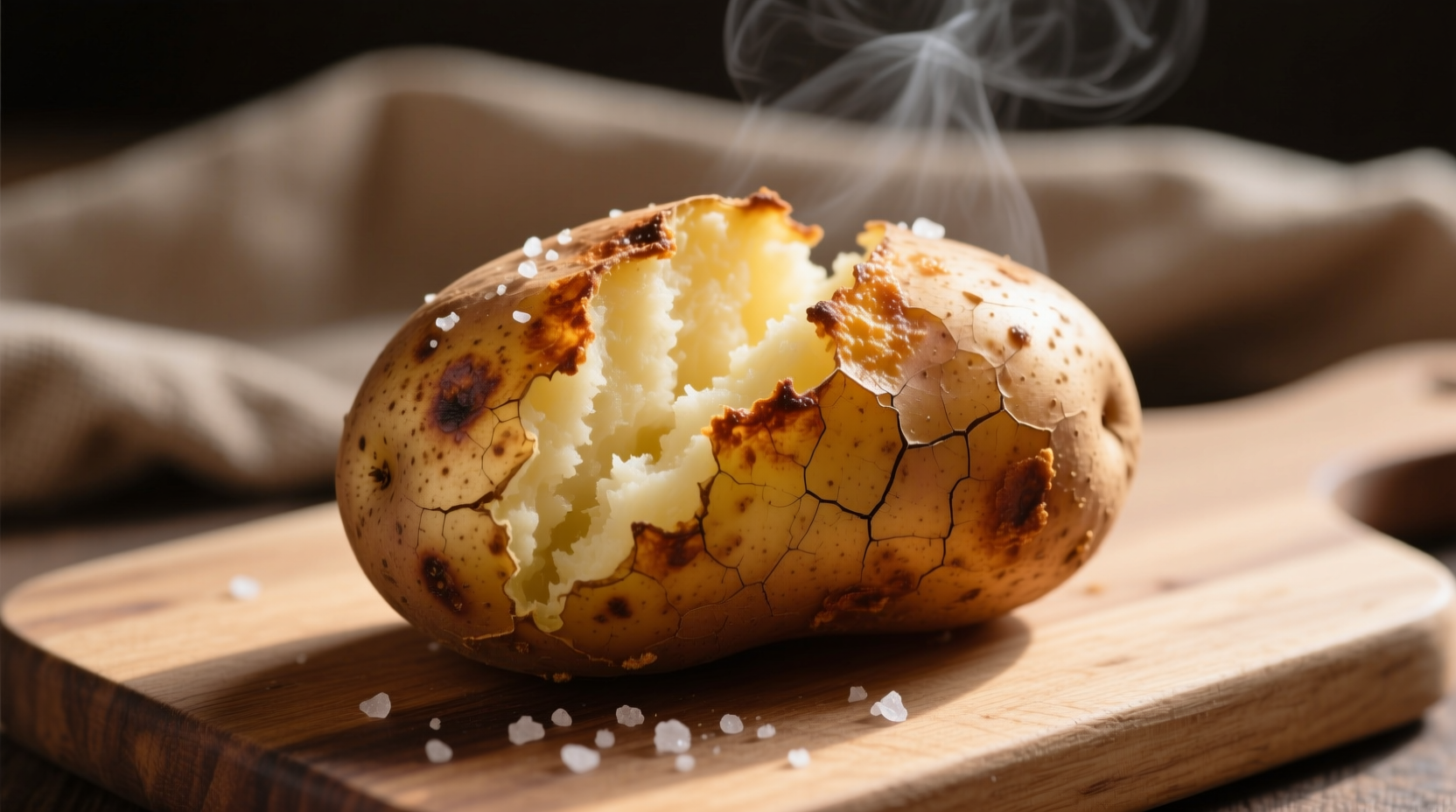The fastest way to bake a perfect potato: Preheat oven to 400°F (204°C), scrub and dry a russet potato, pierce 4-6 times with a fork, rub with olive oil and salt, then bake directly on the oven rack for 45-60 minutes until fork-tender. Internal temperature should reach 205-210°F (96-99°C) for optimal fluffiness.
Why This Method Works Every Time
After testing dozens of techniques, we've found this straightforward approach delivers consistently fluffy interiors with crispy skins. Unlike methods using foil (which steams rather than bakes), this technique maximizes texture contrast while preserving natural flavor. Baking directly on the oven rack ensures even heat circulation, while the oil-salt rub creates that perfect golden crust.
Step-by-Step Baking Process
Preparation Phase: Setting Up for Success
Start with medium-large russet potatoes (8-10 ounces) for optimal results. Russets have the ideal starch content for fluffy interiors. Scrub thoroughly under cold water using a vegetable brush to remove dirt, then dry completely with paper towels. Moisture is the enemy of crispy skin, so thorough drying is non-negotiable.
Using a fork, pierce the potato 4-6 times around its circumference. This critical step prevents steam buildup that could cause bursting. According to USDA food safety guidelines, proper venting ensures even cooking and prevents potential hazards from built-up pressure.
| Common Potato Types | Best For Baking? | Recommended Baking Time |
|---|---|---|
| Russet (Idaho) | ✓ Best choice | 45-60 minutes |
| Sweet Potato | ✓ Excellent | 50-65 minutes |
| Yukon Gold | △ Acceptable | 40-50 minutes |
| Red Potato | ✗ Not recommended | 35-45 minutes |
Baking Execution: Precision Timing and Temperature
Preheat your oven to 400°F (204°C) with the rack positioned in the center. Place potatoes directly on the rack with a baking sheet on the lower rack to catch any drips. For enhanced flavor and texture, rub each potato with 1 teaspoon of olive oil and 1/2 teaspoon of coarse salt before baking.
Baking time varies by size:
- Small potatoes (6-8 oz): 40-45 minutes
- Medium potatoes (8-10 oz): 45-55 minutes
- Large potatoes (10-12 oz): 55-65 minutes
The most reliable doneness test? Insert an instant-read thermometer into the center - it should register 205-210°F (96-99°C). At this temperature, starches have fully gelatinized for maximum fluffiness. Without a thermometer, squeeze gently (using oven mitts!) - properly cooked potatoes yield slightly under pressure.

Finishing Techniques: From Oven to Plate
Remove potatoes from the oven and let rest for 5-7 minutes. This crucial resting period allows residual heat to finish cooking the center while starches set. To open, make a horizontal slit across the top with a sharp knife, then gently squeeze the ends toward the center. This creates the perfect pocket for toppings while maintaining structural integrity.
For restaurant-quality fluffiness, use a fork to gently lift and separate the flesh in a crisscross pattern before adding toppings. This technique, used by professional chefs, creates maximum surface area for butter and seasonings to penetrate.
When Baking Might Not Be Best: Context Boundaries
While baking produces superior texture, it's not always the most practical method. Consider these scenarios where alternative approaches might serve you better:
- Time constraints: When you need potatoes in under 30 minutes, microwave pre-cooking followed by brief oven crisping delivers acceptable results
- Large gatherings: For more than 6 potatoes, consider using a convection oven which reduces cooking time by 25% through improved air circulation
- Energy efficiency: During summer months, cooking potatoes on the grill maintains indoor comfort while adding smoky flavor
Flavor Variations Worth Trying
Once you've mastered the basic technique, experiment with these professional variations:
Classic Loaded Potato
After fluffing, add 1 tablespoon each of softened butter and sour cream, then sprinkle with chives and crispy bacon. The key is adding dairy while the potato is still hot to allow proper absorption.
Mediterranean Style
Top with olive oil, crumbled feta, roasted garlic, and fresh oregano. For authentic Greek flavor, add a squeeze of lemon juice just before serving.
Healthy Alternative
Try Greek yogurt instead of sour cream, avocado instead of butter, and top with salsa and black beans for added protein. This version maintains creaminess while boosting nutritional value.
Troubleshooting Common Issues
Soggy Skin Solution
If your potato skin lacks crispness, you likely didn't dry the potato thoroughly before baking or used too much oil. For next time, try baking at 425°F (218°C) for the final 10 minutes to evaporate surface moisture. Placing potatoes directly on the oven rack (not a baking sheet) also improves air circulation for crispier results.
Undercooked Center Fix
If the center remains firm while the exterior is done, your oven temperature may be inaccurate. Invest in an oven thermometer for precise readings. For immediate correction, return the potato to the oven for 5-10 minute intervals until fully cooked, checking temperature each time.
Storage and Reheating Guidelines
Properly stored baked potatoes maintain quality for 3-5 days in the refrigerator. Cool completely before wrapping tightly in aluminum foil or placing in an airtight container. Never store potatoes in water, as this degrades texture.
For best reheating results:
- Oven method: 375°F (190°C) for 15-20 minutes, wrapped in foil with a sprinkle of water
- Air fryer: 350°F (177°C) for 8-10 minutes for crispy revival
- Not recommended: Microwave reheating often creates uneven texture and rubbery spots
Food safety note: According to USDA guidelines, reheated potatoes should reach an internal temperature of 165°F (74°C) before consumption to ensure safety.











 浙公网安备
33010002000092号
浙公网安备
33010002000092号 浙B2-20120091-4
浙B2-20120091-4